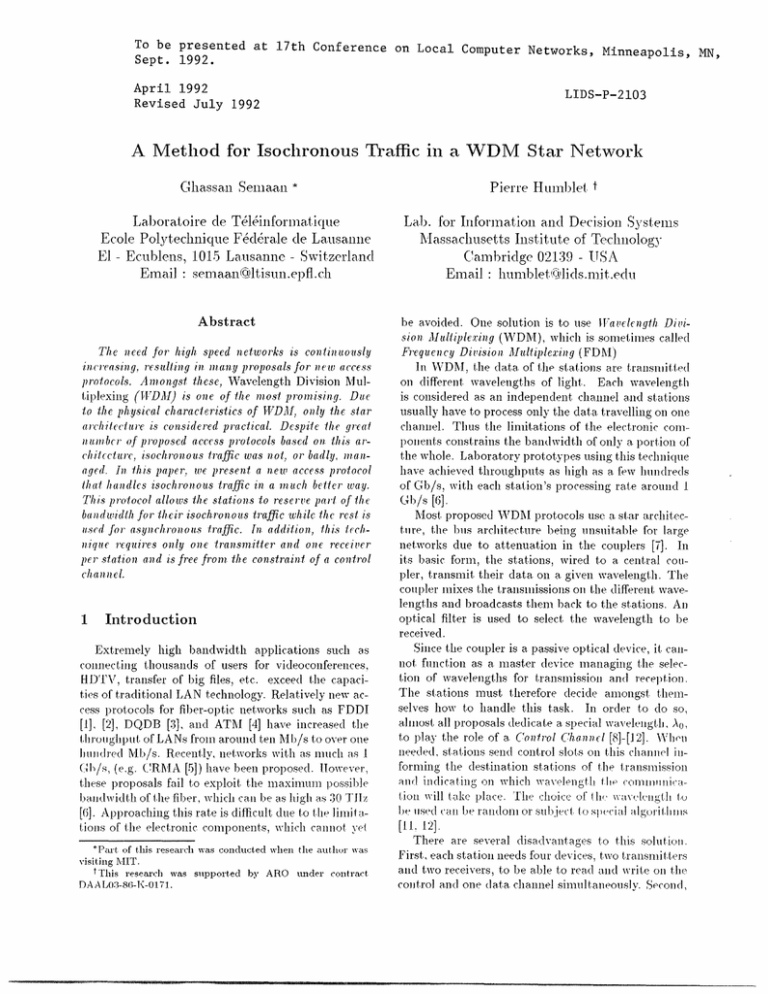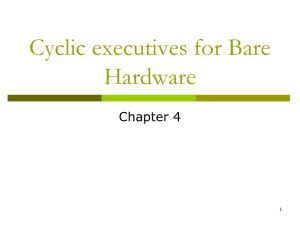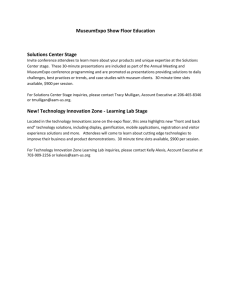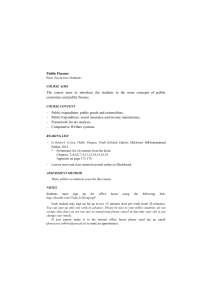To be presented at 17th Conference ... Sept. 1992. LIDS-P-2103 April 1992
advertisement

To be presented at 17th Conference on Local Computer Networks, Minneapolis, MN, Sept. 1992. April 1992 Revised July 1992 LIDS-P-2103 A Method for Isochronous Traffic in a WDM Star Network Ghassan Semlaan * Laboratoire de Tele'informat.iqlue Ecole Polytechnique Fld6ra.le de Lanusanne El - Ecublens, 1015 Lausanne - Switzerland Ema.il: sema.a-nctltisunl.epfl.ch Abstract The need for highl speed networks is continuouitsly increasing, reslult.ing in inanl.y proposals for nerw access protocols. Amongst these, Wavelength Division MAultiplexing (WDilfM) is one of the most promising. Diue to the physical characteristicsof Wl'TDMI, only the star architecture is considered practical. Despite the great il.nbllme r of proposed access plrotocols based on. this atchitccture, isochllronous traffic was not, or badly, ilIanaged. In. this paper, we. present a nevw access protocol that handles isochrono.us traffic in a m1uch better uay. This protocol allowus the stationls to reserve par(t of the balndwttidth. for their isochronoits traffic while the rest is used Jor asyl.chron.ous traffic. [I. addition, this iech.nique requires only one transmitter and one receiiver per station7 an.d is free from. th.e constraint of a control channel. 1 Introduction Extremely high bandwidth a.pplica.tions such as connectinlg thousands of users for videoconferences, HD'ITV, transfer of big files, etc. exceed the ca.pacities of tra.clditiona.l LAN technology. Relatively new access protocols for fiber-optic networks such a.s FDDI [1], [2], DQDB [3], and ATMI [4] ha.ve increased the throulghplut. of LANs frolmaround ten Mb:/s to over one ltluljdred Mll:)/s. Recently, networks with a.s mulch as . (:bI/s, (e.g. C(R.MA [5]) have been proposed. Ilowever, these l)roposals fail to exploit the maxilmum possible )a.m(lwr idt.ll of the fiber, which canll e as high as 30 TIlz [6]. Approa.ching this rate is difficult due to tlhe limritations of the electronic components, which cannot. vet *Part of this researchll was conducted when the authll(r w-aso visiting MTIT. t'rhis research was supported by ARO under contract DAALo:3-86-K-01 71. Pierre Hulniblet. t La.b. for Informnation and Decision Systems Massachusetts Institute of Technology Cambridge 02139 - UTSA Email: hullmbletil ihdsm.nit,.eclu be avoided. One solution is to use 1"'aelenl.gth. Divlisionlilltileielng (ANWDMA), which is sometimes called Frequeincy Divisioan Mulltiplexing (FDAI) In X\DM, the data. of the sta.tions are transrlitted on clifferent wavelengths of light. Each wavelength is considered as a.n independent channel and stations usually have to process only the data. travelling on one channel. Thus the limitations of the electronic cornponlents constra.ins the bandwidth of only a. portion of the whole. Laboratory prototypes using this technique have a.chieved throughputs a.s high as a. few hundreds of Gb/s, with each station's processing rate around I GC/s [6]. Mlost propose(ld WDMITprotocols use a. sta.r architectitre, the bus a.rchitecture being unsuitable for large networks due to attenuation in the couplers [7]. In its basic form, the stations, wired to a. centra.l coupler, transmit their data on a. given wavelength. The coupler mixes the transmissions on the different. wa.velengths and broadcasts them ba.ck to the stations. An optical filter is used to select the wavelength to be received. Since the coupler is a. passive optica.l device, it cannot function a.s a. master device managing the selection of wavelengths for transmission an(d recept.ion. The stations must therefore decide amongst themselves how to handle this task. In order to do so, allllost all proposals dedicate a. special wavelength, A(, to play the role of a. Control Channel [8]-[12]. XWhn needed, stations sendl control slots on t.his channiel informing the destination stations of t.he transmission and indicating on which wavelengtllh tl. comiiniii'iawa.leugt h t. tilon will take place. The choice of t le Ilsed canll e randonl or subject. to special algorit.lhils [11, 12]. There are several disacdvantages to this solutioln. t First, each statioll needs four devices, two tra.nsmi1t.ters a.llnd two receivers, to be able to read a.nd write on the colitrol a.n l one (ata. channel simulta.neously. Secon d, the throughput of the network depends heavily on t)hat needed by each station to transimit its data, and one of the control channel: a.s nmore stations try to send tunable receiver to select the wavelength to ble read. data,, only those who successfully transmlit, their conBoth devices a.re capable of tuning on all wavelengthls. trol information will be able to transmit on the data. If all the low loss regions of a. single-mode fiber are channels, even though the bandwidth of the network used, tip to 1000 stations can use the network simulcan handle a. much larger number of communications. taneously. Tlis problelll ecollles nlore dramatic whle tIe control channel is a.ccessed in a, ranldoln manner (ALOHA-S Tunable Tunable USERS Transmitters USERS or slotted ALOIIA protocols). Finally, even though USERS access schemes on the control channel may handle Passive i a.synchronous data. in an a.dequa.te marnner, they do 7 tar not offer good support for the isochronous 2 case. Silnce Coupler X mlany future applications such a.s video conferences, I-HD)TV, and so on, will generate isochronols data., it 2 2 2 is important that the network be able to handle bothll . / z ' types. One possible solution for this problem is to dedica.te a. whole channel for an application tlhat. needs ' to transfer isochronous data. This solution will suffer from a. great loss of bandwidth as very few applicaN tions need 1 Gb/s, which is tihe usual channel ra.te in WDM. Therefore the channels should be shared by diff'erent. applications generating either asynchronous or isochronous data. The purpose of this paper is to present a, new acFigure 1: The star architecture cess schelme to control data translnission in a. WDMA star network. In this protocol, asynchronous and isochronous data simultaneously and dynamlically share 2.2 The Frame the same chalnnels. Moreover, this access sclleme requires only one tunable transmitter and one tunable Data. a.re transmlitted in slots. Slots a.re nmultiplexed receiver and does not need a control channel, contrary into fraimes as the one presented in figure 2. Frames canl have, for example, a duration of 125 ps to facilitate to the inmain protocols in [13]. In the following sections, interconnection wit.h pulblic switched netxworlks. we outline the basic properties of the network, give a. detailed description of the access schenle, and discuss Each fraime is made of (N+5) slots. The first five somle aspects of the data transmission. a.re called Control Slots (CS) and serve for the transmission of control information. The remaining N are called Data. Slots (DS) and serve for the transnlission 2 Network Description of clata.. The DS can be of two types : Reservled and Free. 2.1 Physical Architecture 11'When R.eserved, a.DS can be accessed by only one station to transmlit isochronous data.. When Free, it can be accessed by any station to transmit asymnchlronous The network has the star architecture proposed in data.. For reasons that will ble explained ill section 4, figure 1. Each station is assigned an indlependent the first, AI DS are always Free and their type caniwavelength and is connected to a.passive star coupler. not be modified. The last (N-M) DS can be Reserved The wavelengths a.re mixed at the coupler and broa.dcast to all stations. Only one tunable transmitter is or Free and their type is indicat.ed in the contlrol slou, ,S'laltls. The valuecs of Al alllnd N are ilmplemllllll.atioi - Asyncllhronous data : data that is send at. irregular perio(l of (ime. In this case t.he bandwidth can be shared stat.ist-icallv (let-'lellt.. Sd between different stations. These data are generated typicallych by applications such as distributed operating systems, Network File Syst.ems (NFS), ... ill deal with two dliferet-t tvlces Of fiame. The first., seen by the transmitter, consists (of tihe transmitted slots. Thus, it is called Tran.sililtcr 2Isochronous data : data that is send at. regular period of time and needs guaranteed bandwidth to meet. performnlce requirellents. These data are generated by applications such as video and voice communications t st Frae (F). e secoe receiver ' ' of thle received slots and is called Receiver Frla.e (R.F). The difference between these two framles is dclue to the Always Free Data Slots Reserved or Free Data Slots S10tN Slot [ .............. Control Slots .............. S10tM.l.S10tM .............. SlottM+l Slot I Slot M Status ACK ID .............. ramr [SYNC] Figure 2: The structure of the frame factl tha.t the stations do not t.ra.nsmit and receive data. on the same wavelength. Only the CS are transmitted on the dedicated wavelength of a station. The DS a.re transmitted on the wavelength of the destination stationl (la.lde plossible by the use of a tunable tranlsmnitter). On the other la.d a. station tunes its receiver to the different wavelengths to read the CS of any station then tunes ba.ck to its dedicated wavelength to read the data. slot sent to it. This approach is illustrated ill figure 3. In this figure stations 1, 2 alld 3 are assigned wavelengths A1, A2 and A3 respectively (the frames are simplified to one CS and four DS). If we consider station I for example, this station will send its control slot (slot with a "C" is the miliddle) on its dedicated wavelength, A1, then tulle its transl-itter to wavelength A2 to send slots I and 3 to sta.tioll 2 and to wavelength XA 3 to send slot 4 to station 3. For reception, it will tune its receiver to A2 to read the control slot of station 2 then tune back to its dedicated wavelength (A') to read the data. slots sellt to it by station 2 (slots 1 and 4) a.nd station 3 (slot .3). An equiva.lent. behaviour is executed by stations 2 and 3. For ease of reference we define we define the ,Soource a.s the transmitting station and the Destinationas the station to whom the data is addressed. It. should be noted that a station does not necessarily rea.cl the CS of only one station eachl fra.me duration. For any frame, it can for example rea.d the Sta.tus slot, on Ai a.nd the ACK slot, on Aj with i : j. 3 The Access Scheme In this section we will describe the a.ccess schemne used to control tranlsnission on the network. To economize space only the fundanlental parts are shown. Thle principal components of the a.ccess sclleme are the C'Ss. CSs are exploited in different ways dependilg on the type of data, to send. Three differentl types can be handled by the protocol. In addition to the asynchronous and isochronous ones introd.luced earlier in this paper, we adcld the Bulky Data. Bulky Dat.a. is a.special ca.se of the asynchronous type, one where the TrrIT 1 2 IT 3 Hub Hub TR 3 TR 2 TR 1 ' XI1 _ . 2 3 I ~ EmptySlot C:ContolSot TT :TunableTransmitter l ! I:TunableReceiverTR TF:TransmitterFrame RF:ReceiverFrame Ps Rs Figure 3: The Transmitter and Receiver Frames amount of data. to send from one station to a, destina.tion is big. Therefore, three types of transmissions are possible, one for each type of data. We will explain first how the CS work, then we will show how they are used with these different types of data.. 3.1 The Control Slots Before any new transmission, the station will rea.d the St atfus slot of the Destination. The Status slot. indicates the state (Reserved or Free) of the DS in the TF and R.F. Based on this, the Source checks whicih slots are Useful Slots. A Useful Slot (US) is a. slot. that. is free in the TF of the Source and t lie BF of the Destiinat;iou silulta.neously. For exampnle. if' statioIn A has slots 3, 1 and 8 free for transmlission andl statioll 13 has slot. 4, 7 and 8 free for reception, the US for a. transmission from A to B are 4 and 8. Oince thlle TUS have been checked, the station will choose thellslots t;o use for its transnission. However, due to the data. ra.te a.ndcl size of the net.- Receiver Transmitter Station B Station A StatFIN0& (*) FNO \ Framek-3 FNI \F / FNO Framek . ACKk-3 FNI . Status- Famek+1 AKk-2 F re FN2 \ Status k+2 Framek-l 2li . /.' FN2 FN2 Framek+2 . R FnNO time Status k+3 Frame k Frame k+3 FN1 FNI ACKk-l / Fraek. 4FNO ACK k (**) % Frame AC() k+3 FN, Status k+4 Frame k+l Frame k4 ACKk+l 1.. a) Status .... .~ b) Acknowledgement Figure 4: Status and AC K, (R=3); work, the Status slot cannot be used to represent the state of the DSs of thle physical friame to which it belongs. It cannot because the transmitters will coInplete tra.nsmission of the DS of a. frame before the receivers are alble to rea.d its Status. There mnust therefore be a. delay between the tra.nsl-ission of the Status and its corresponding DSs, large enough to insure that all receivers have received the Status before any of the DS is transmitted. This delay can be insured by introducing the Cycles. Let T be the propa.gation delay from the transnlitter to the receiver of the point that is at the maximuli clista.nc.e allowed from the hub. We define the Cycle as consisting of R framles wllere R is the smnallest integer bigger than (1 + T/(fra.me duration')). In the C.S Fralm.e Nullber (FN), ea.ch frame is given an incremlenta] numlll-er modulo R. that indicates the position of the fra.me in the Cycle. Therefore, to be useful, the Status should indicates tl-e type of the DS of the framlne wit]l the sa.m.e FN but in the next cycle. In this case, all the receivers will receive the Status before ainy of the DS concerned a.re transmitted. In figure 4.a,, a. tilning cliagram showing how the Status works is given. In this exa.mpllc R.=3. Inl framc FNO, the tra llsmitters will send the status of tle DSs to be sent. three frames later, whllich is the next cycle. lWhen the Status reaches the receivers, none of the DSs of the next. FNO fram.le ha.s been sel)t. Therefore, using the Status, the stations can decide in which slot they can senld their data. The C(S A CG' is used to a.cknowledge the reception of the DS. Its use is almost similar to the Status and is expla.inecd in detail in section 3.2. There remain two CS that have not yet been pre- sented: the ,SY'iVC and the Identificatio.,. The ,'iYNC slot is used for the synchroniza-tion of tlhe network. Whell lsing tile slot switching techniqle with NVDM, the alignment of the slots becolnes a. major problem if different stations ar.e sending on the sam.le wavelength. IFN In n [14] we solved this problem using the SYNC and gave a. structure for the slots. Thlle Ideli.tificat.iol. (ID) slot identifies the stations tha.t is using a. given wavelelgthll. It should be rea.d periodically to allow the stations to maintain a. table tha.t indicates which wavelength is used by which station. 3.2 Asynchronous Data Thlle access for asynchronous data. is based on the slotted ALOHA protocol [15]. After checking which are the US, the station will ralndomly choose awmolngst. them the number necessary for the transmission, and will then transmlit its data.. If two stations choose the same slot, a. collision will occur and both slots will be lost. As tlie stations do not rea.l the slots they ha.ve sent, they are not able to detect thle collisions. Therefore, the Destination should acknowledge the reception of the DS by using the ACK. For each DS received without an error the Destilation will set the corresponding bit in the AClK. Once all the DS of a. framle a.re received, the Destination will send the ACK slot in the next frame with the sa.lne FN as the current frame. As with the Sta.tus, the ACK ca.lnot be used to acknowledge tIhe DS l elongilg to thle same physical frame. ACK acknowledge the DS received in the fra-me with the sa-lme FN but in the previous cycle. Therefore, the stations, remembering in which framne and which slot they have sendl their data., read t-wo cycles later the corresponding ACK slot and get the results of their transmissions. In figure 4.1) a. timing dia.graml resumes how the ACK works. In franme FNO, station A send the data. of frame k (referenced with a. "*"). Once all the DS have reached station B, this st.atioln wvill acknowledge the reception of thle slots in the ACK of the next FNO fra.me (referenced wvithl a. ** ). The dura.tion of the C-cle was chosen to be b.igger than th te mllaximlum propagation delay so that. it. is illdel.)ed(elelt of the distaluces of tlhe stal iolls f'oIC)tlI mub. The (+ 1.) is to allow the stations to receive all thle cla.ta slots before sending the ACK. Thlisi)ecaiuse if' we only consider the propagation delay, a. station may not have finished the reception of the DS of the fra.llle prior to transmission of a.new framle with the same FN (cf. figure 4.1)). The slots that a.re not acknowledged a.re retra.nsmitted.s Due to the fact that only one Status and one ACK slot can be rea.d each fra.me, only one asynchronous transfer can be initiated in each framle duration. However, with a. fram.e luration of 125 Its, this would allow eight thousands asynchronous transmlissions per second for each station. Station A Status Al h , Status B 1 Station B , Status B t Status Al h - ... (Station o ConnReq C) statusB1 Stat soConnReq Isochronous Data Status StausA 2 Iso_ConnReq Status A2 \ 3.3 Station A Station B Status B2 2 soConnConfim Status A2 \ A -I..Connonf , Status B2 7Co onnReject Isochronous transfer takes place in reserved slots. If the available bandwiidth obtained by the US thla. can be reserved is sufficient, the sta.tion will initiate an isochronons conlDnmunication by sendinlg a.n IsoC'o n ._Request(Isochronous Connection Request) in an a.synchronous manner. With the Iso(-ConnilR.equest., the sta1tion will indicate the minbers of the slots that it wishes to reserve for its communica.tion. M\loreover the Source will reserve a. TUSin its Receiver Franme, the Antswering Slot, to be used by the Destia.tion to answer the request. Followinlg this, the Source will modify its Status accordingly. It should be noted however, that the slots that are requestedl by the Source for isochronous transfer but not yet confirled, can still be used by the Source for asynchronous transfer until the confirmation of the connection. Aftier the tra.nsmission of the IsoConnRecluest three events Ill.may ha~ppen : 1. Collision : The request will collide withl data. tranlsmlitted in the samite slot by a~nother station. The Source will detect the collision by reading the ACK of the corresponding fra.rne two cycles later. In this case, the Source restarts the process. 2. (llha.nge in Status : The Status of the Destinmation ma.y change during the propagation of the lsoConnRequest (cf. figure 5.1b). Int this ca.se the Destination will send an Iso-Conn-Reject inh tlie Answerilng Slotl indica.tillg tIle motives of thle rejection. After the reception of the rejection, the Source may. or may not resta.rt the process. 3. Successful Transmission : The re(l.est reaclhes the Destination without a. collision and the slots requested by the Source can be reserve(l. In this case the Destination will send an IsoClonnlConfirml in the Answering Slot confirming the reservation. Following this the Destination will modify- its Sta.tus accordingly (cf. figure 5.a.). Status 2 StatusB 2 a)Successful Tansmission StatusA 3 \ ,StatusB 2 b)Change of Status Figure 5: Establisling a. isoclronous communication At the reception of the Confirl, tlhe Source will sta.rt tra.nsmitting its dla.ta only in the reserved slots. Once the commu nicatio n is finished, the Source will send an Iso Disconect. Contrary to the asynchronous data, the slots that a.re tra.nsmitted in an isochronous lanner a.re not actheooRe isest dclue to two fa.cts: the first is that. After kowledged. thetransmission ofThis in most isochronous applications, acknowledgement. is useless, and the second is that isochronous tra.ffic does not get involved in collisions. This allows the stations to have multiple isochronous communications simultaneously. 3.4 Bulky Data 13ulky dla.ta, as previously stated, is a. special case of asyllchronous data, where the amounlt of clata. to send from one station to a. destination is big. Unless the load of the network is low, transmitting this t1)ype of lata. in a.slotted ALOHA protocol will clecrease tle performances of the network due to the rise in tlhe number of collisions. Therefore we transmit Bulky Data. in an isochronous manner. Once a Bullky Data transfer is requested, thme st.lioil choose tlle necessa.ry slot.s flor its t.ra.11swill randomlyl Tlleli it. that can be reserveld. nmission amongst. the TUS will send a BIl_C'onm_RequEst (Bulky C(onnection lelquest) in an asynchronous manner. The esta.blishmlent of the communication is identica.l to tlhe isochllronous one with one small difference. If, during the propagation of the request, the Des- tination modifies its Status, then it will confirl-m the reservation of the slots that a.re still fi:ee and does not reject the connection as its does witlh the isochronouts communications. The Source can afterwards decide if the number of slots confirmed a.re sufficient for its transmission. If not, the Source may try to reserve the remaining necessary slots or may send a. discotinect primitive. Once the connection is established, the Source will send its data only in the reserved slots. As the isochronous data., Bulky Data are not a.cknowledged in this protocol. This may take pla.ce in a. higher layer. In [16] different studies of acknowledgemnent techniques for high speed networks are presenlted. This option was chosen to allow the stations to have multiple simultaneous bulky communications in addlition to the isochronous an(l asynchronous tralsmissions. Moreover, with Bulky comllmunications the slots a.re free from collisions. Therefore, few slots need retransmission and high level acknowledgement ca.n have a. very good performiance. 4 Discussion again here. 7What should be noticed however, is that this type of protocol offers very good performances ) when the load of (rea.l throughput, access delay, the network is low. Therefore it will be used only when the stations 1lave few slots to send. For the tra.llsmission of a. bigger amount of data., we introduced the bulky type. An acknowledgement for the asynchronous data. is necessary because the Sources are not ab)le to detect the collisions by themselves. In the exa.rnll)le we show, we present.ed a very simple type of acknowledgement : Collision or No Collision. HTowever, the ACK can be used to inforrm the Source of other possible prol)lenis. The Destination may loose a. slot for reasons such a.s loss of synchroniza.tion, a. buffer tha.t is full, etc. By using two bits instead of one for acknowledging ea.ch slot, the Destination can indicate for the Source the different. reasons for the loss. Depending on the reason, the Source may or may not delay the retransmission of the slot. 'The bulky da.ta. a.re transmitted in reserved slots t.o reduce the amounlt of da.ta transmitted in a. slotted ALOHA mannler. This is due to thlle fa.ct (,al tt uder heavy loa.d the performances of a. slotted ALOHA protocol degra.des. As withl a.sy;ncllronous clata. thle rotocol degrades. As with asynchronous data, the In this section we discuss the options chosen for example given is very simple. A lot of improvement the da.ta. slots. Those chosen for the control slots have cani be made for this type of data.. For example, with le, it ca e ade for tis type of data. For exa been dliscussed a.s they have been presented thllroughotlent t(hicusede pa a~s they havebeenprentithper.roughtihe connection request, the Source can indica.te the oliniilluIll andl mnaximluln ntulmber of slots it. needs for .its transmission. of da.ta. As we would like tle three different. types Ase ould of like latatethreedifrent types The Destination will reserve continuwe defined (i.e. asynchronous, isochronous and )ullky) lllm numnlber requested and, cdleplendcling ously the mninimulllm to share the same channels simlulta.neously, a slotted onIL thle ba.ncldwidthll available and o0 tIle recluests fiom protocol wa.s chosen. A slotted protocol gives us the other stations, will reserve an additioa.l variable nuinber of slots. Tie Ada.tive Bandwidth Allocation techopportunity to define different types of slots, mainly Reserved a.nd Free. The reserved slots will be used nique is actually under development and will handclle to.to guarantee uara.tee a. a. minimum iniiII1 bandwidth ba~ndwiith for for the the stations stat-...ions .this type of problemls. A notion of priority can be also with isochronous da.ta.. This guarantee is a. mandatory reqluirement for isochronous transfer. The remaining introduced. slots, those t.h.a.t are not reserved, a.re used for the isoclironous transfer, a. Rearrangeiewt ~a~~synlchron~ous transfer. technique is under development. This teclhnique will synhonous the trfandl cases where the Source and the Destina.tion In order to always be able to reach any station, we have sufficient. baidwidth for an isochronous coiiihiaRve to guarlanltee a. m nitimumi unuiber of' slots that. llnication, but the free slots in each station d(o iiot cowill always be Free. This is necessary, a.monlgst. other incide. Therefore a. modifica.ion of the reserve slots bandwidth This managelment. things, for the network necessary in order to illncrease the nulnber of tTS. tl-iings, niaaiia-gemen networol~k for~u tre Thisis is obtained with the first M slots in ea.ch frame. Due to the physical characteristics of the lpassive optical star, managing the bandwidtlll is a. major prollemn. For asynchronous transfer we decided to choose 5 Conclusion a. randoml access which, in this case, is t.he simplest. W0e presented ill this paper the control access a.ccess. As our network is slotted, slotted ALOHA scllmee of a. new protocol for transmitting (la.fa ill a. plrotocol wa.s chosel. 'rhe perfornma.nces of the slot.passive optica.l star network. This protocol supports ted ALOHA protocol has been heavily studied in the three different. types of data, asynchronous, bulky and literature [17, 18], therefore we will not discuss themn isochronous sha.ring simultaneously the same chanllnels. The method presented does not require a Coiitrol C(ha.lnel and uses only one tunablle translllitter and one tuna.lle receiver. We introduced the Cycles with the Sta.tus and the ACK andl showed how these notionls allows the stations to have a. view of the state of the heub n. network despite the pa.ssive na.ture of' the hl. we gave an example of the tra.nsmission for each of the three types defined. Finla.lly we discussed the differelt options chosen. We a-re in the process of eva.luating the performa.nce of this protocol through simulation. Further work remains to be done to provides additiona.l funlctiola.lities. [10] CG.N.MAI.Sudhakar, N.D. Georgana.s, 1I. Ka.vehrad. Slotted Aloha, and Reservation Aloha Protocols for Very High-Speed Optical Passive Sta.r Topology. Jotrn-al of Lightfware Technology, 9(10):14111422, Octoler 1991. References [13] P.A. Humblet, R. Ramaswan.ii, K.N. Siva rajaln. An Efficient Comlmunicationl Protocol for HighNet;wors. Speed Pa.cket-Switched IMulticha.nnel ACM ,'igC01o11m'92, August 1992. [1] ANSI. FDDT - token. ring media. access con.trol (MA C). Technical Report X3.139-1987, ANSI, November 5, 1986. llhen, N.R.. Dono, R.. R.ala.sv a.i. A leclia Access Protocol for Paclet-Switched W7a.velength Division Multia.ccess Metropolitan Area. Network. IEEE Jolrnal on Selected Areas i1. C10o11micaions,,(8):1048-1056, August 1990. [12] Y. Ofek, l. Sici. Design and Analysis of a. Hybrid Access Control to an Optica.l Sta.r using WDMI. pp 2A.3.1 - 2A.3.12 Inlfocom'l91, 1991. [2] ANSI. FDDI- hybrid ring control. Draft. Proposed X3T9.5/89-43 REV5.0, ANSI, Felruary 24, 1989. [14] G. Senmaaan. P. Humllet. Issues for Slot Tranlsmission ill a.Passive Optica.l Star Netlworlk based on WDAM. subnitted to Globecomn'92 Orlando, Florida [3] IEEE. Distributed Queue Dual Bus - metro politan. area network. Unapproved Draft P802.6-/D14, IEEE, July 1.3, 1990. - December 6-9 1992. [15] L. R.olerts. ALOHA Packet system witll a.nd without slots a.nd capture. C'om iputer Caomm7. Rev., [4] (C(CITT. (ISDN,). 1988. IIntegrated Services Digital Network Recolnmendations 1.121, Melbourne [5] AM.Nassehi. CRMIA : an a.ccess scheme for high speed LANs and MANs. IEEE Int. Conf. Coinmu ni cations, 1697-1702, April 1990. [6] C.A. Bra.ckett. Dense Wavelength Divisionl i\lltiplexing Networks : Principles and Applications. IEEE Joui'.rnal o011Selected Areas in Comm unications, 6(8):948-964, August 1990. [7] P.S. IIenry. High Capa.city Lightwave Local Area Network. IEEE Co1mm.. Mag., 27(10):20--26, Octol)er 1989. [8] I.M. Ha.l)la.b, AM.Kavebra.d, C.E. Sundllerg. Protocols for Very IHigh-Speed Optica.l Fiber Local Area. Networks Using a. Passive Star Topology. Jour, al of Lighl wave Technology, LT-5( 12):1782-1 793. Decenilber 1987. [9] N. Iehra.va.ri. Performance andcl Protocol Improvements for EVery High Speed Optical Filber Local Area. Networks Using Pa.ssive Star Topology. Joutrhnal of Lightvwave Technology, 8(4):520-530, April 1990. 5(4):28-42 April 1975. [16] 1W.A. Doeringer et al. A lWeight Transport Protocols for works. IEEE, Transactionls 1 (orks. 1EEE, Transoclis on Survey of Light High Speed Netcommunications, C0 1 [17] D. Bertseka.s,R. Gallager. Data Netwuorks. Prentice Hall, 1987. [18] A. Tanenba.um. Computer Nethorks. Prentice IIa.l, second edition 1989.




